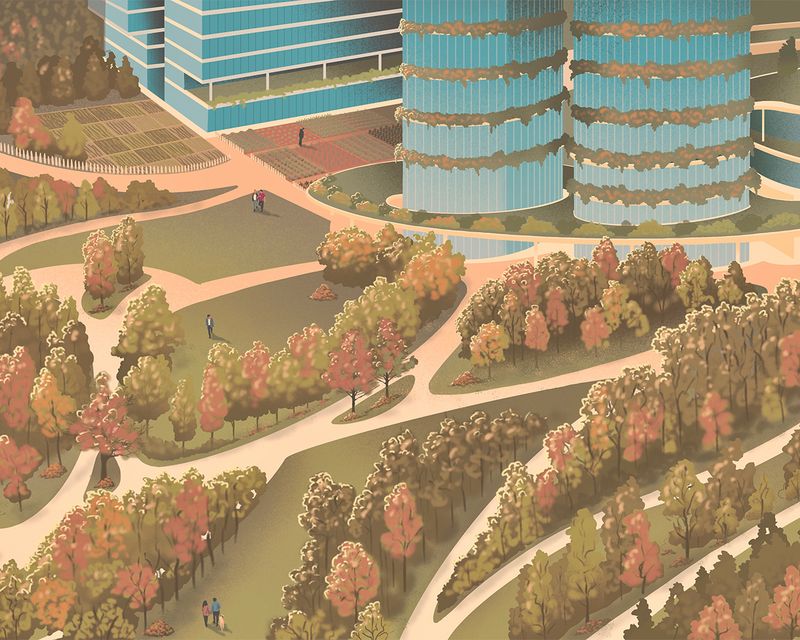THE JOURNAL

Illustration by Mr Avinash Weerasekera
As the countdown to the holiday season commences, the nights start to draw in and the temperature drops, it can be tempting to retreat from the world and sit out winter in the warmth of the indoors. In more balmy weather, all it takes is the prospect of a day on the beach or a picnic in the park to get us out of the house. But when the trees are bare and the ground is hard, it can be a lot more difficult to find the motivation to get out into nature.
If you were to spend the coldest months of the year inside, however, you would miss out in more ways than one. Apart from not getting a chance to enjoy the changing beauty of the winter landscape – the low sun glinting on the morning frost, the crisp air, the clear pale sky – spending time in nature has considerable benefits for our physical and mental health. Research shows that, regardless of the season, being outside and connecting with nature can have positive effects on everything from managing stress to getting a better night’s sleep, and in winter, when the lack of sun can seriously affect our mood, it is particularly important to get out and brave the cold.
To get some tips on how we can connect with the natural world this winter, we spoke to two people who relish the arrival of the colder weather – Ms Helen Jukes, a nature writer, and explorer and endurance athlete Mr George Bullard.
01.
Be more aware of the changing light
For many, the worst part of winter is commuting in the dark. But the shorter days also offer the opportunity to be more aware of the passage of the sun through the sky and the natural cues that regulate our sleep cycle. “The dark is a big part of connecting with nature for me,” says Jukes, who is the author of A Honeybee Heart Has Five Openings and is working on a novel about climate anxiety, intimacy and the solar system. “I miss the dawn and dusk in midsummer, and love the feeling of being more in touch with circadian rhythm.”
Jukes likes to go for a walk at first light or dusk when the quality of light can transform your surroundings. “Somewhere as familiar as your local park can be some completely changed in the half-light,” she says. “It no longer seems to belong to the human world.”
02.
Go on an adventure
When we speak, Bullard is in Saudi Arabia, on the latest of his many record-breaking expeditions. But, as he explains, you don’t need to set out on an incredible feat of athletic endurance to make going outside an adventure. “For me, a lot of the charm of winter is in getting dressed up warm and simply stepping outside of the comfort of your own home,” he says. “You can go on some pretty exciting miniature adventures just by exploring your local area, whether that’s the centre of the city or the countryside.” He suggests that you use a head torch if it’s dark when you head out. “And now that the leaves are falling, you can get some excellent views by climbing a tree. You don’t even have to go too high, but it will give you a different perspective on your surroundings.”
03.
Eat seasonally
There are also ways to connect with nature inside the home this winter. “I love gathering root vegetables and winter greens from the allotment, throwing them all in a big pot on the hob and leaving the soup to simmer all morning,” says Jukes. Eating only what is in season can be a great way to stay aware of seasonal changes, as well as minimising your impact on the planet by not accruing hundreds of “food miles”. If you don’t have access to an allotment or a garden to grow your own food, try to buy seasonal produce at your local grocers. Look out for parsnips, carrots, cavalo nero, sprouting broccoli and “the dreaded swede”.
04.
Switch off
Even if you have a good relationship with your phone, it still pays to get some quality time away from your gadgets, especially when we tend to spend so much more time in front of a screen. “Leaving your devices at home is a really nice way to get closer to nature without spending money or losing time,” says Bullard. Using a paper map rather than your phone to navigate your way can encourage a more direct relationship with your surroundings. You could even go without a map altogether. “I’m a huge fan of not making a plan,” says Bullard. “You could just walk for 15 minutes in one direction and then turn left, and keep doing that until you’re back where you started. It gives you a pretty immersive experience and you feel like you’ve been outside with a purpose.”
05.
Give something back
“One of the best ways to connect with nature is to leave it in a better way than when you found it,” Bullard says. This could be as simple as picking up litter when you see it or looking out for wildlife as the weather becomes more inhospitable. “Bird and bat boxes, piles of undisturbed sticks or leaves all offer important shelter, and leaving out food and water helps birds and small mammals through cold spells,” suggests Jukes. “Just remember to break the ice if the water freezes!”
